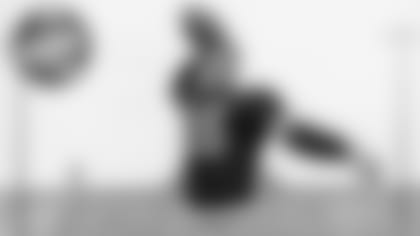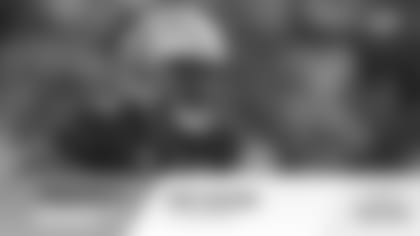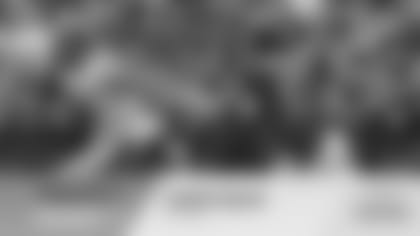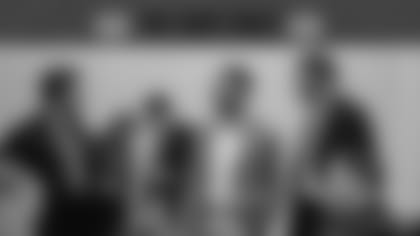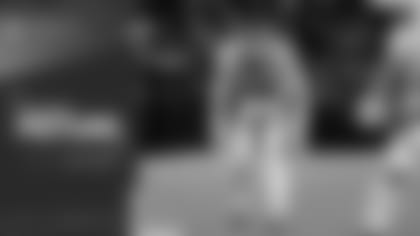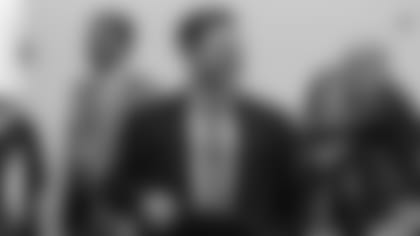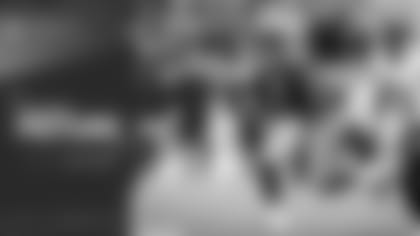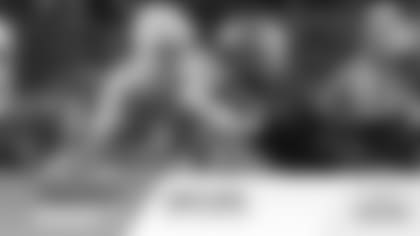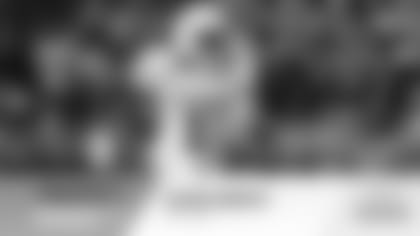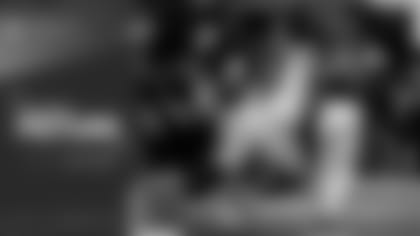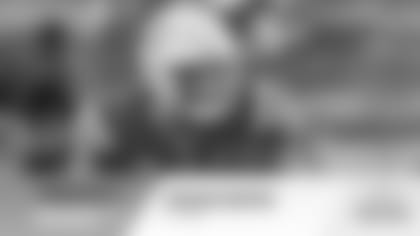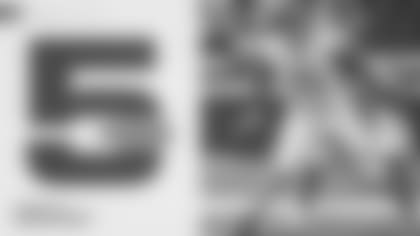*Cliff Christl started gathering oral histories with former Packers and others associated with the team in 2000 and will continue to gather them as Packers historian. Excerpts from those interviews will be periodically posted at **www.packers.com*
Vito "Babe" Parilli played quarterback for the Packers from 1952-53 and again from 1957-58. Parilli was selected by the Packers with the fourth overall pick in the 1952 NFL Draft, although they already had a promising young quarterback in third-year pro Tobin Rote. Parilli had played collegiately at the University of Kentucky under Bear Bryant, finishing fourth in Heisman Trophy voting as a junior and third as a senior. In his first two seasons with the Packers, Parilli shared quarterback duties with Rote. Over the next four years, he was part of two blockbuster trades between the Packers and Cleveland Browns. Three weeks after Parilli entered the Air Force in July 1954, he was traded to the Browns along with Bob Fleck, who also was in the service, for quarterback Bobby Garrett, the No. 1 pick in the 1954 draft, and three other players. Parilli spent two years in the Air Force, then played with Cleveland in 1956, sharing starts with Tommy O'Connell and George Ratterman. In April 1957, the Packers reacquired Parilli in an eight-player trade that also sent Garrett back to the Browns. Parilli shared quarterback duties with Bart Starr in 1957 and '58 before being cut in 1959, 12 days before the opener, by first-year coach Vince Lombardi. After one-year stints with Ottawa of the Canadian Football League and Oakland in the first year of the American Football League, Parilli joined the Boston Patriots in 1961 and served as their starting quarterback for most of the next seven seasons. He also led them to the 1963 AFL championship. In 1993, Parilli was inducted into the Patriots Hall of Fame. He finished his playing career with the New York Jets from 1968-69 and backed up Joe Namath when they won Super Bowl III. From 1971 to 1973, Parilli served as an assistant coach with the Pittsburgh Steelers. In 15 NFL and AFL seasons, Parilli passed for 22,681 yards.
On why he thought the Packers drafted him No. 1 when they already had Rote: "I don't know why. We alternated every other quarter. He would start one game and I'd come in the second quarter. He'd go in the third and I'd come in the fourth and vice versa. I'd start the next game and he'd come in the second. We played about a half each my rookie year. So it worked out all right."
On the rotation in 1953: "We followed the same system. It worked pretty good the first year. The second year wasn't too good."
On his relationship with Rote and how they differed as quarterbacks: "Tobin was great. We had no problem. We got along very well. Rote was a good runner. He probably ran too much and got hit a lot. I think it was good for the team. The protection was suspect at times and he could take off; I could scramble, too."
On Gene Ronzani, the Packers' coach in 1952 and most of '53: "I liked Ronzani a lot. I thought he was a player's coach. He communicated well and maybe too much. He was a good person. The old philosophy back then was coach through fear like Bear Bryant, Lombardi. But (Ronzani) had his own philosophy. He was a nice guy and I felt he thought he could get the best out of players by doing it his way."
On why some of his teammates might not have been as fond of Ronzani: "You hear a lot of funny stories about him. He'd never look at you. He'd always have his head down talking to you. When he talked in meetings, you'd hear the shower leaking and he'd go back there and be talking and turn the shower off. He was a funny guy. I wouldn't say he was the best organized coach."
On why Ronzani wouldn't look people in the eye: "That's a good question. Maybe it was an insecurity thing from when he was growing up. I'd have to get a headshrinker. I don't know."
On any memorable stories about Ronzani: "One thing I remember about him was we went to the Polo Grounds in 1952 and beat the Giants. We were on the way back to the airport and he said, 'Wait a minute, Bussy, we got time for a drink? Pull into the cocktail lounge at the Concourse Plaza.' So we all had cocktails before we went to the airport. We were all happy because we weren't expected to beat Steve Owen and the Giants."
On whether it was true Ronzani never gave the players a playbook: "We had cards. They'd lock them up in the basement on Washington Street, where the old office was, or somewhere. We had them memorized. It was a tough system, the old (Clark) Shaughnessy system, where you had to tell everybody on the team what to do. You used boys and girls names. If you used, 'Grace,' it was a girl block. You'd say George-E or Grace-Ed. Put a boy and girl block together. A girl block meant you blocked the halfback and a boy block meant you blocked the linebacker. Anytime you used a T, it would be a tackle. You were telling him what to do. If you used 'E,' it would be the tight end."
On what the cards were like: "They were about 10 by 12 with plays on them. There were black markers with red for the defensive players. We didn't have a lot of plays because it took so long to call the play. Like East, two right, 39 toss, Tess-Ed crack, 26 on 2, stuff like that. That was one play. You had to memorize it. That would be a sweep. East was the formation. Two right would be the wing going out to the right. You'd say, '39,' three back, nine hole. It would be a toss. Tess-Ed. That would be the tackle and end block. Crack, you'd have the guy coming back and cracking on the halfback. I forget what the 26 meant. They all used it. The Bears had it. Clark Shaughnessy was the Bear coach. He was the one who originated it."
On whether there were a lot of mental mistakes as a result: "No, just the quarterback had to memorize it. If you were a tackle and I'd tell you 'Tess,' that meant you went and blocked the halfback because it was a girl block. If it was 'Tom,' that was a boy block and you'd go block the linebacker. So it was pretty easy for a lineman. They must have thought the linemen weren't very smart. The quarterback was supposed to be the smart guy and tell everybody what to do."
On Chuck Drulis, the line coach who had played for the Bears, including when Ronzani was an assistant coach: "He knew the system. He'd always hold the cards up in practice."
On the Packers being one of the first NFL teams to use the shotgun under Ronzani;"Tobin would use that because he could run out of it."
On a passage in a book about Bear Bryant where it stated former Packers president Emil Fischer approached you about contacting Bryant to see if he might be interested in coaching the Packers: "(Bryant) was thinking the Redskins. I don't know about the Packers. George Preston Marshall had offered him a deal. He made the right move and stayed in the college ranks. That's the only one I remember. It might have been the '53 season when I heard about the Redskins. I don't remember the Packers. If (Fischer) did, it was so long ago, I couldn't remember. He might have. I don't know."
On his first two training camps with the Packers at the Minnesota Agricultural Experiment Station in Grand Rapids, Minn.: "The mosquitoes were big as birds. We didn't have any transportation. We weren't allowed to have a car. Once a week, the coaches would let us use the bus to go into Grand Rapids. We'd sneak a few beers back with us. I remember one time Tobin Rote and I buried a six-pack of beer and Gene Ronzani found it. I think we buried it right by the building there. He made us run a little bit. But at the end of practice, if we won our race at our position, he would give us a beer. There wasn't much excitement up there."
On playing in Green Bay in the 1950s: "Green Bay was a good town. The problem was everybody knew you, so you had to be careful if you had a few beers. They'd call the coaches. It was a small town, if you were a partying guy. The Piccadilly was the hot spot."
On playing at old City Stadium, behind Green Bay East High School: "I remember the first game I played there. It was against the Cleveland Browns, an exhibition. Lou Groza kicked off and the ball went so high, you couldn't see it until it came down behind the fans in the stands. The lights were so bad. That was the first thing I remember about that stadium. Horace Gillom was punting over the lights."
On being traded to Cleveland after being called into service: "When I left, (the Packers) had to get a quarterback. Bobby Garrett was the first pick with the Browns, but Otto Graham was playing and they knew he was going to retire. So (the Browns) figured when I got out, I'd take (Graham's) job. I was going to spend two years in the Air Force and (the Packers) couldn't wait two years. They had to get somebody and that's probably why they did it."
On playing with the Browns in 1956: "I got hurt – a rotator cuff. I was the starting quarterback there and Gino Marchetti got me from the blind side. They never did operate, but it took me about six, seven months to recuperate. That burned my career with the Browns. They didn't know what a rotator cuff was back then. They just couldn't understand why I couldn't get well. Actually, what happened was Paul Brown dressed me for every game, but I couldn't throw the ball 10 feet. He didn't want anyone to know that. Tommy O'Connell came in and he started. If I would have gone in, I would have had to just run the ball. That's why (Paul Brown) traded me."
On whether the Packers knew about the injury when they reacquired him the next year: "That's a good question. I don't know."
On whether he was damaged goods: "When I got there, I was OK. I went down to Kentucky and this old country doctor friend of mine injected me with cortisone and said, 'Go out and throw as hard as you can and break that scar tissue.' I'll be darn if it didn't work. It was like seven months later. It might have been in the spring. I was throwing good then. I came back (to Green Bay) and there were no problems. Being young had a lot to do with it. Today, they'd operate on that the next day."
On Lisle Blackbourn, the Packers' coach in 1957: "I had no problem with him."
On Scooter McLean, the Packers' coach in 1958: "Everybody liked Scooter. But he didn't have a mean bone in his body, except maybe when he played ball."
On what changed under Lombardi in 1959: "In the '50s, '60s, it was all based on talent. The teams that had the best talent could run the vanilla offenses and overpower teams. When Lombardi came in, running the sweep, he'd say, 'Well, we don't care if they know we're coming.' And that's what they did."
On his time in training camp that year under Lombardi: "I quarterbacked the first win he had. We played the 49ers (in the second preseason game) and (later) he cut me. I have no idea. I had a good game. I thought I had a good camp."
On whether he was trade bait: "(The Packers) wanted me to go to Philadelphia. (The Eagles) were interested because I had a good game against them the year before. They said they wanted me to replace Sonny Jurgensen. Can you imagine that? They wanted me to back up (Norm) Van Brocklin. I said I didn't want to sit on the bench and went to Canada."
On Lamar McHan, a five-year veteran who started the opener for Lombardi in 1959 after being acquired in a trade: "He was more of an option quarterback. I wouldn't call him a great passer."
On second-year quarterback Joe Francis, who was McHan's backup and ahead of Bart Starr on the depth chart early in the 1959 season: "He was more of a runner."
On Starr: "He was a senior in high school when I was a senior in college. He visited Kentucky and I worked with him. He came up for about 10 days. Ermal Allen (later a Dallas Cowboys assistant) was my quarterback coach at Kentucky. He was a great coach and he instructed me on the finer points of playing the position."
On Billy Howton, the Packers' leading receiver in 1952 and '53: "Howton was a good receiver. He had good speed. And he had good body control. He was good intermediate, deep. We used to accuse him that he didn't like to go across the middle and get hit. That was the rap on him."
On Bob Mann, the Packers' first modern-era African-American and second leading receiver in 1952 and '53: "He had great moves and got in the open spots. Big, long hands. He had great hands."
On issues Mann had as the Packers' first black player: "It was so hard for those guys. I had a high school teammate who went to the University of Indiana and played there. He could have made the pros: a black kid. I called Jack Vainisi to see if I could get him a tryout with the Packers. I'll never forget, he said, 'Babe, we've got six black guys on the team now.' That was during my second time around with the Packers. We played together at Rochester, Pa. His name was Harry Tallon, a defensive end. He never got a tryout and became a correctional officer in Pennsylvania."
On Joe Johnson, a back for the Packers from 1954-58: "He was an all-purpose guy. He'd stick his head in there."
On Gary Knafelc, Packers offensive end from 1954-62: "He was a steady tight end. He would always yell my name out when he was open."
On his game-winning touchdown pass to Knafelc in the Dedication Game at Green Bay City Stadium, now Lambeau Field: "I had to avoid the rush. That's when I saw Knafelc in the end zone and fired it into him. All I know it was a big play to beat the Bears. They brought in some pretty big celebrities and it was a big deal at that time."
On whether it was a big deal for the players to also move from the old stadium to the new:"Are you kidding me? It was like the Taj Mahal compared to East High. Back then, you had to appreciate those things. Now, you've got so much, it's so overwhelming, you take it for granted. But we were pretty overwhelmed with it. I was anyway."
On Ron Kramer, the fourth pick in the 1957 draft and a starter as a rookie before going into service and then later Knafelc's replacement: "He was as good or better than any tight end Green Bay ever had. He was the best blocker. He was a great athlete. He could have played professional basketball."
On any other special thrills he remembered as Packers quarterback: "I remember a game against the Eagles in (1958). I threw four touchdown passes. I remember throwing the ball to (Max) McGee. I threw him a perfect pass in the end zone and he dropped it. He came back in the huddle and I said, 'Max, I'm going to give you another chance.' So we called one to him and I threw a terrible pass and he jumped up and made a great catch for a touchdown."
Parilli died in 2017 at age 87. The excerpts above were taken from interviews conducted in 2002, 2003 and 2007.
- *



